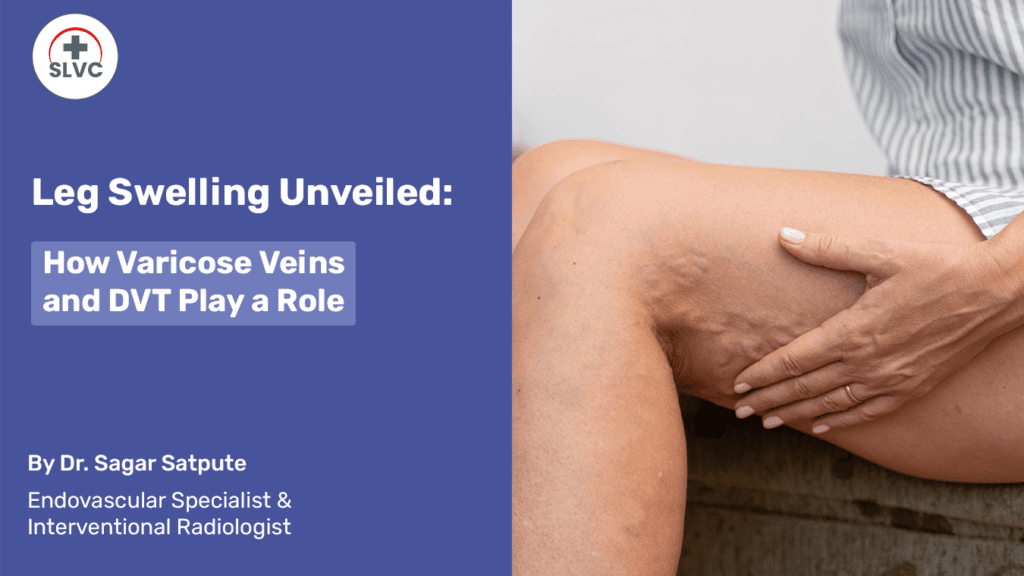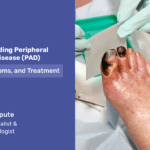Mobile
+91 8369559053
drsagputelimbandvesselcare@gmail.com
Leg Swelling Unveiled: How Varicose Veins and DVT Play a Role

Table of Contents
Overview
Swelling in the legs can be a concerning symptom, often indicative of underlying health issues. In this comprehensive exploration, we delve into the intricacies of leg swelling, dissecting the roles of varicose veins, deep vein thrombosis (DVT), and ulcers in causing this discomforting condition. By understanding the mechanisms at play, individuals can better grasp the importance of early detection, appropriate treatment, and proactive measures to safeguard their leg health.
Understanding Leg Swelling: A Complex Puzzle
Leg swelling, or edema, occurs when excess fluid accumulates in the tissues of the legs. It can be a result of various factors, ranging from venous insufficiency to systemic conditions. Among the primary contributors to leg swelling are varicose veins, DVT, and ulcers.
The Varicose Vein Connection: Venous Insufficiency Unveiled
Varicose veins, those bulging and twisted veins visible beneath the skin, often play a prominent role in leg swelling. These veins result from weakened valves that fail to effectively propel blood back to the heart. Consequently, blood pools in the veins, causing them to enlarge and contributing to edema in the lower limbs. The elevated venous pressure further exacerbates fluid accumulation, resulting in discomfort and visible swelling.
Deep Vein Thrombosis: A Stealthy Culprit of Leg Swelling
Deep vein thrombosis (DVT) emerges as another notable cause of leg swelling. DVT entails the formation of blood clots within the deep veins, commonly occurring in the legs. These clots obstruct blood flow, leading to increased pressure within the veins and eventual fluid leakage into the surrounding tissues. The consequence is leg swelling, often accompanied by pain, warmth, and redness—a combination that should prompt immediate medical attention to prevent potential complications.
Ulcers: The Hidden Source of Leg Swelling
Ulcers, characterized by open sores on the skin, can also contribute to leg swelling. Chronic venous insufficiency resulting from varicose veins or DVT can compromise skin health. Over time, this can lead to skin breakdown and the development of ulcers, most notably venous ulcers. These ulcers release inflammatory substances that further contribute to fluid retention in the affected leg, intensifying the swelling.
Synergistic Interplay: Multiple Factors Amplifying Leg Swelling
In some cases, the causes of leg swelling can intertwine, magnifying the discomfort experienced. For instance, individuals with varicose veins might be more susceptible to DVT due to the compromised blood flow. Conversely, DVT can lead to venous insufficiency, further exacerbating the likelihood of swelling. This intricate interplay underscores the necessity of addressing each underlying condition to effectively manage leg edema.
Early Detection and Timely Intervention: A Pillar of Leg Health
Recognizing the signs of leg swelling and its potential causes is paramount. Unexplained swelling, accompanied by other symptoms such as pain, skin changes, or warmth, should never be ignored. Seeking prompt medical evaluation can aid in identifying the root cause and devising an appropriate treatment strategy.
Navigating Treatment Avenues: Tailored Approaches for Varicose Veins, DVT, and Ulcers
Treatment options for leg swelling are as diverse as the causes themselves. For varicose veins, interventions like endovenous laser treatment (EVLT) or radiofrequency ablation can address venous insufficiency, thereby reducing swelling. DVT management might involve anticoagulant therapy to prevent clot progression and swelling. Ulcer treatment necessitates wound care and addressing the underlying venous issues.
Preventing Leg Swelling: Embracing Proactive Measures
Prevention proves to be an invaluable approach in managing leg swelling. Maintaining an active lifestyle, practicing proper leg elevation, and avoiding prolonged periods of inactivity can help improve circulation and mitigate the risk of venous insufficiency. Moreover, understanding one’s genetic predisposition and seeking timely medical advice can empower individuals to take preventative steps.
Conclusion: Empowering Leg Health through Awareness
Leg swelling is not merely a discomfort; it can signify deeper underlying issues. Varicose veins, DVT, and ulcers stand as significant contributors to this condition. By comprehending their roles and recognizing the symptoms, individuals can proactively engage in their leg health. Early diagnosis, tailored treatment, and proactive prevention can collectively weave a path toward healthier, edema-free legs—a journey that requires awareness, knowledge, and a commitment to one’s well-being.
Latest Blogs
Understanding DVT: How Blood Clots Can Lead to Serious Consequences
February 24, 2024





